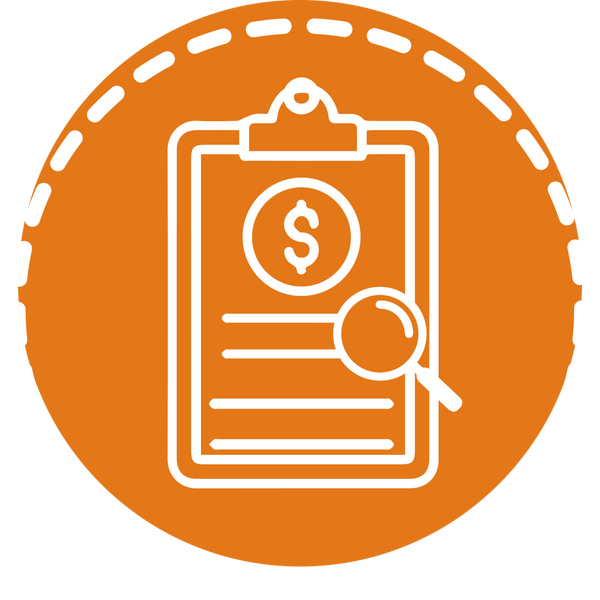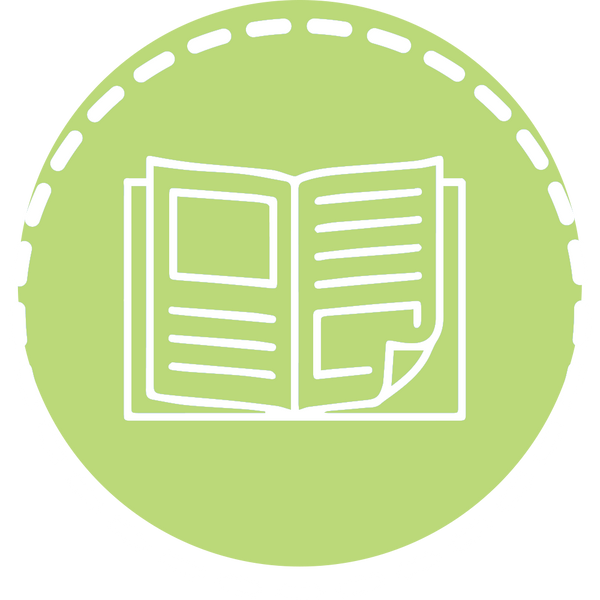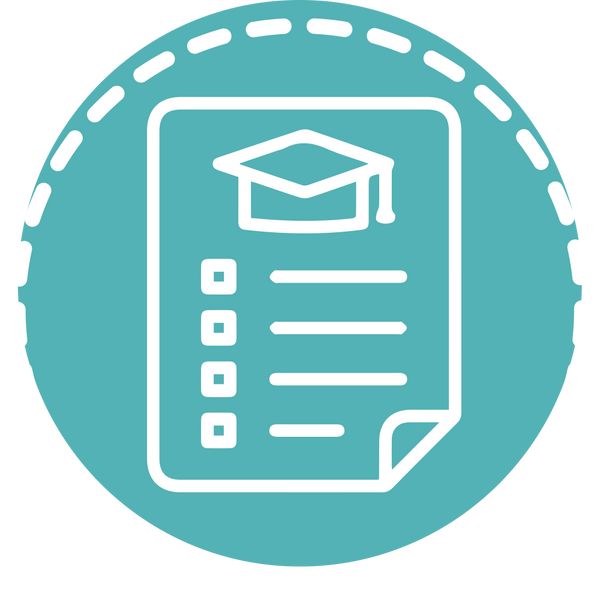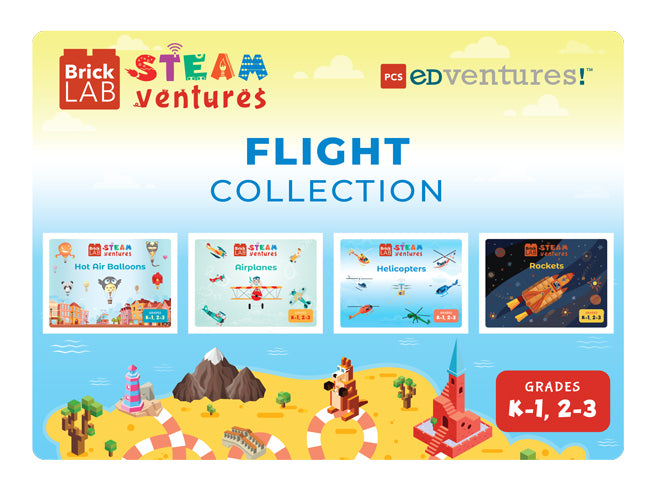
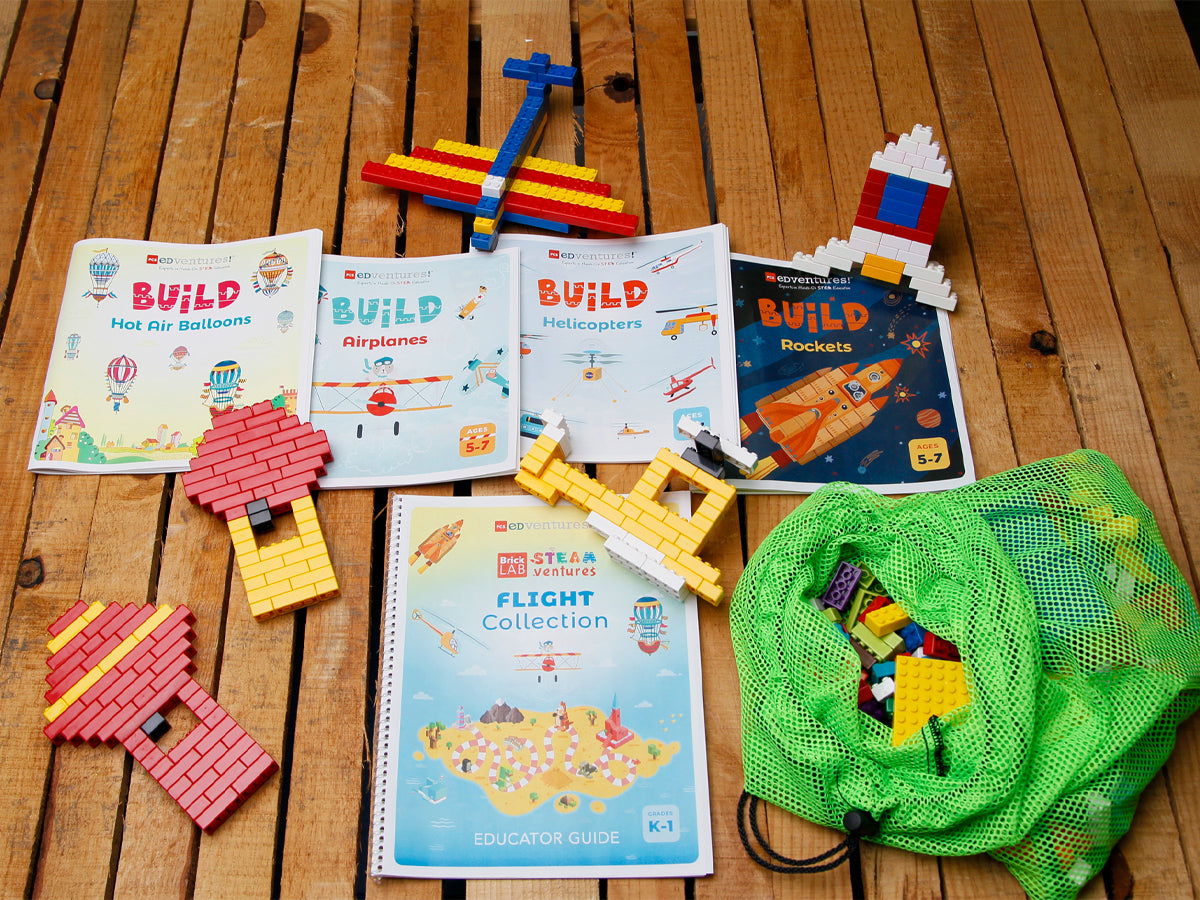
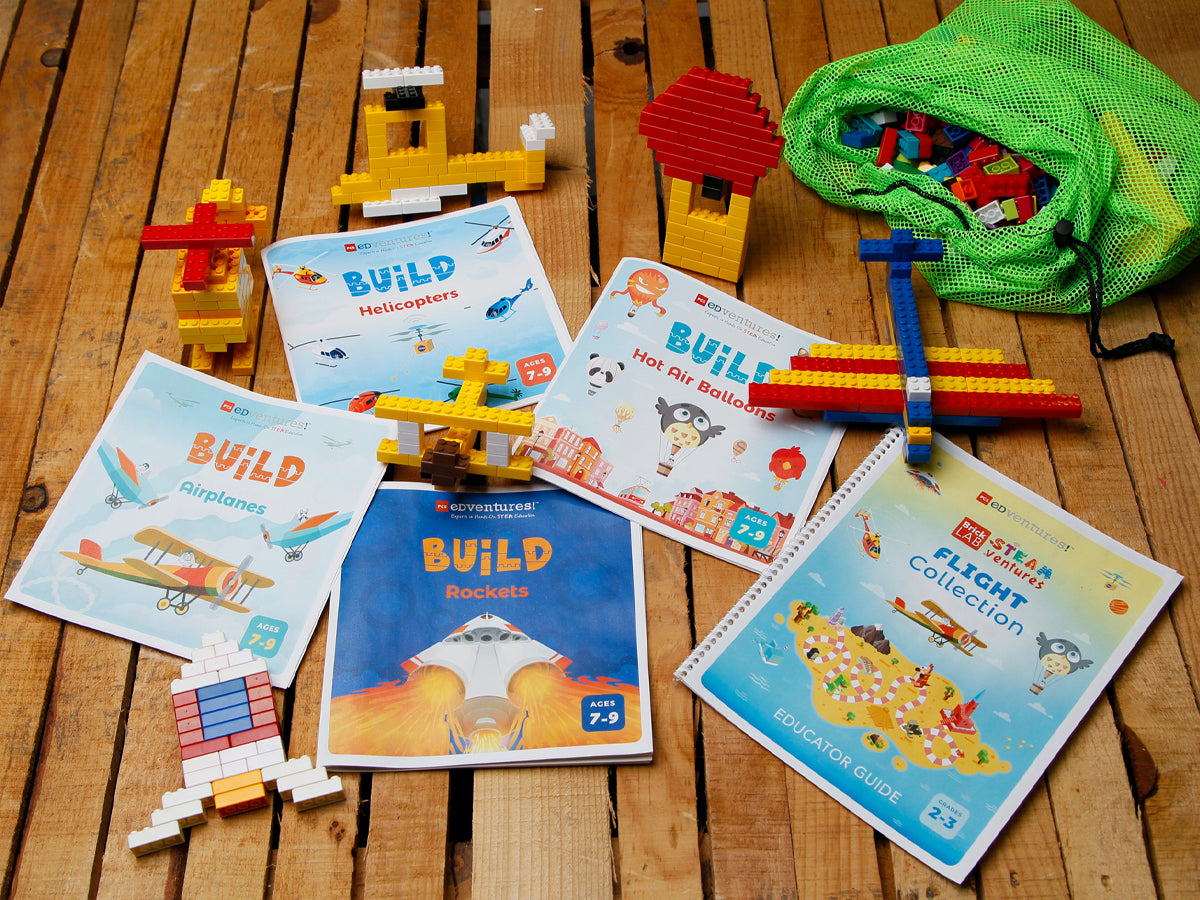

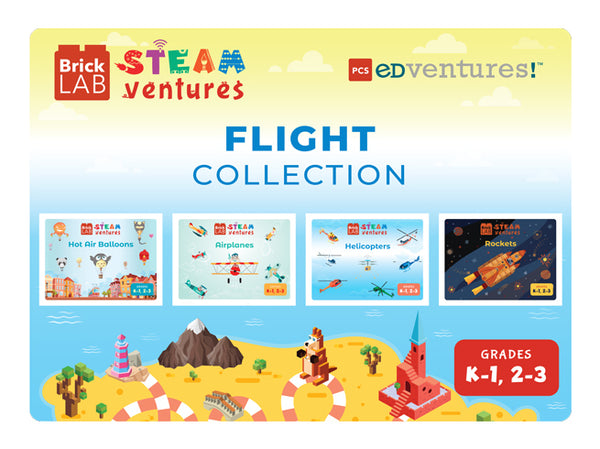
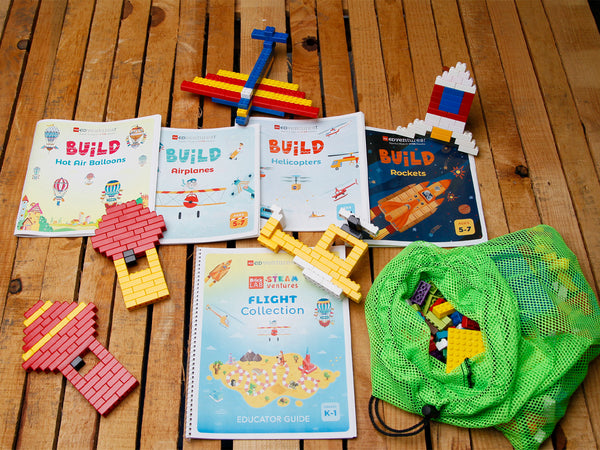
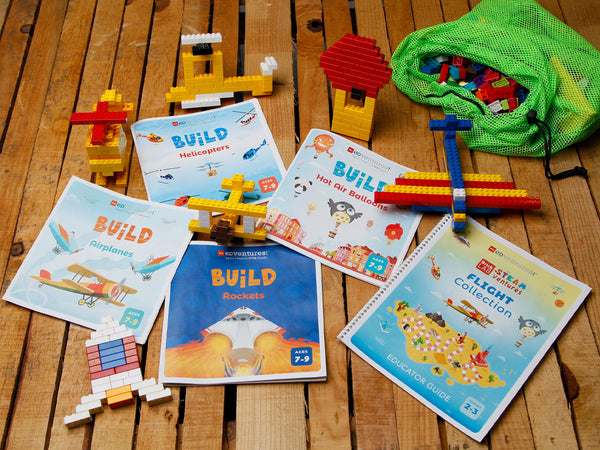
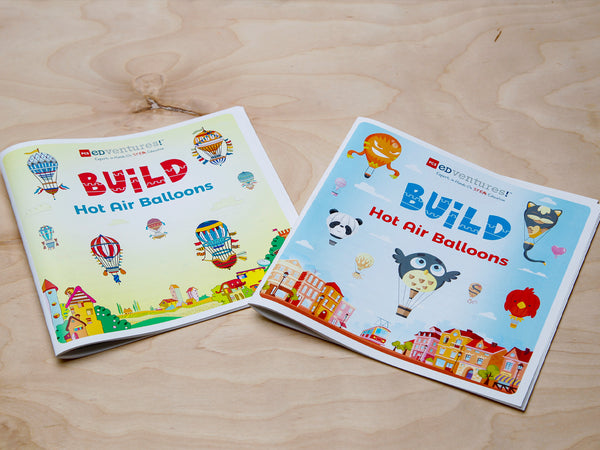










BrickLAB STEAMventures: Flight Collection
- Price
- 595 USD
BrickLAB STEAMventures: powered by curiosity!
Custom Ordering Available
Contact a STEM Program Specialist at (800) 429-3110 or sales@edventures.com for custom bundles, quotes and bulk discounts!
BrickLAB STEAMventures: Flight Collection takes students on a journey through the skies to explore the history and engineering of human flight! In this collection, you’ll explore:
Hot Air Balloons: Take flight with the inventors and innovators of the past and explore the science, history and engineering design behind hot air balloons.
Airplanes: Investigate who invented the airplane, learn the secrets that let them fly and discover how airplanes are used today.
Helicopters: Examine the unique features of helicopters and discover what makes them the perfect flying machine for search and rescue, traffic monitoring, space exploration and more.
Rockets: Investigate space with early astronomers, learn about the scientists, engineers and mathematicians that make spaceflight possible and discover the secrets that let rockets fly.
BrickLAB STEAMventures enriches K-1 or 2-3 grade learning no matter the environment it’s introduced in! As a student-driven kit containing manipulatives, grade-appropriate curriculum and optional extensions, this program hinges around family engagement and a STEAM-themed activity book brimming with multi-subject integration. Whether it be at home, in the classroom, after school or through a hybrid setting, this brand new program is innovating education and helping to strengthen the partnership between educators and parents. BrickLAB STEAMventures is individually kitted to keep students safe, provide flexibility to educators and works with or without technology. With hands-on builds, problem-solving challenges, critical and creative thinking activities, arts connections and so much more, BrickLAB STEAMventures is your surefire way to give your youngest students a positive STEAM experience.
Grades: K-1, 2-3
Contact Hours:
- Book Activities: 16+ hours
- Online Extensions on build.edventures.com: 16+ hours
Subject Targets:
Physical Science, Technology, Art/STEAM, Math, English Language Arts, Social Studies
Expansion:
- BrickLAB Program Expansion: Once you have PCS Edventures BrickLAB STEAMventures brick kits, you can easily expand your program by adding new BrickLAB curriculum titles.
Settings & Tech Requirements
Recommended Settings:
- Summer Camps
- Before & After-School Programs
- Classrooms
- Homeschools
Tech Requirements:
- Optional online extensions require an internet-connected device.
Curriculum Topics
Each Issue Includes:
- Key Terms
- Step-by-Step Brick Build
- Science & Social Studies Content
- Math & Literacy Activities
- Art Integration
- Brick Engineering Challenge
- Unplugged & Digital Choiceboards for Family Engagement
Professional Development
Product Orientation:
- Half-hour free webinar orientation for purchases of $500+
- One-hour free webinar orientation for purchases of $1000+
- Additional training available for purchase
Materials
Each 10-Student Bundle (Bricks + Books) includes:
- Instructor Guide: 1
- Printed Student Materials: 10 sets
- 40-page BUILD Books: 4 per student (1 each of Hot Air Balloons, Airplanes, Helicopters and Rockets.)
- Individual Brick Kits: 10
- BrickLAB Bricks: 300+ per kit
- Brick Separator: 1 per kit
- Mesh Bag (for cleaning bricks): 1 per kit
Each 10-Student Bundle (Books Only) includes:
- Instructor Guide: 1
- Printed Student Materials: 10 sets
- 40-page BUILD Books: 4 per student (1 each of Hot Air Balloons, Airplanes, Helicopters and Rockets.)
Standards & Alignment
K-1st & 2nd-3rd Grade
Habits of Mind:
16 thinking habits developed by Art Costa and Bena Kallick to empower students to succeed in a 21st-century learning environment.
- Persisting
- Thinking Flexibly
- Striving for Accuracy
- Creating, Imagining, Innovating
21st Century Skills:
A set of widely-applicable abilities essential for success in the information age.
- Creativity and Innovation
- Flexibility and Adaptability
- Initiative and Self-Direction
- Productivity and Accountability
© 2019 Battelle for Kids. battelleforkids.org. All Rights Reserved. Battelle for Kids was not involved in the production of this product and does not endorse it.
Next Generation Science Standards:*
- NGSS K-2-ETS1-1 Engineering Design
- NGSS K-2-ETS1-2 Engineering Design
- NGSS K-2-ETS1-3 Engineering Design
- NGSS Core Idea PS1.B Chemical Reactions
- NGSS Crosscutting Concept 6. Structure and Function
- NGSS Practice 3 Planning and Carrying Out Investigations
- NGSS Practice 4 Analyzing and Interpreting Data
- NGSS Practice 6 Designing Solutions
* Next Generation Science Standards and NGSS is a registered trademark of WestEd. Neither WestEd nor the lead states and partners that developed the Next Generation Science Standards were involved in the production of this product, and do not endorse it.
K-1st Grade
Common Core State Standards for Mathematics:
- CCSS.MATH.CONTENT.K.CC.A Know number names and the count sequence.
- CCSS.MATH.CONTENT.1.MD.C.4 Organize, represent, and interpret data with up to three categories; ask and answer questions about the total number of data points, how many in each category, and how many more or less are in one category than in another.
- CCSS.MATH.CONTENT.1.NBT.A.1 Count to 120, starting at any number less than 120. In this range, read and write numerals and represent a number of objects with a written numeral.
- CCSS.MATH.CONTENT.1.NBT.C.4 Add within 100, including adding a two-digit number and a one-digit number, and adding a two-digit number and a multiple of 10, using concrete models or drawings and strategies based on place value, properties of operations, and/or the relationship between addition and subtraction; relate the strategy to a written method and explain the reasoning uses. Understand that in adding two-digit numbers, one adds tens and tens, ones and ones; and sometimes it is necessary to compose a ten.
- CCSS.MATH.CONTENT.1.OA.C.6 Add and subtract within 20, demonstrating fluency for addition and subtraction within 10. Use strategies such as counting on; making ten; decomposing a number leading to a ten; using the relationship between addition and subtraction; and creating equivalent but easier or known sums.
© Copyright 2010. National Governors Association Center for Best Practices and Council of Chief State School Officers. All rights reserved.
Common Core State Standards for English Language Arts:
- CCSS.ELA-LITERACY.L.1.1.B Use common, proper, and possessive nouns.
- CCSS.ELA-LITERACY.L.1.1.E Use verbs to convey a sense of past, present, and future (e.g., Yesterday I walked home; Today I walk home; Tomorrow I will walk home).
- CCSS.ELA-LITERACY.RI.1.1 Ask and answer questions about key details in a text.
- CCSS.ELA-LITERACY.RI.1.4 Ask and answer questions to help determine or clarify the meaning of words and phrases in a text.
- CCSS.ELA-LITERACY.RI.1.5 Know and use various text features (e.g., headings, tables of contents, glossaries, electronic menus, icons) to locate key facts or information in a text.
- CCSS.ELA-LITERACY.RI.1.10 With prompting and support, read informational texts appropriately complex for grade 1.
- CCSS.ELA-LITERACY.RL.1.10. With prompting and support, read prose and poetry of appropriate complexity for grade 1.
- CCSS.ELA-LITERACY.W.1.8. With guidance and support from adults, recall information from experiences or gather information from provided sources to answer a question.
© Copyright 2010. National Governors Association Center for Best Practices and Council of Chief State School Officers. All rights reserved.
Next Generation Science Standards:*
- NGSS K-PS2-2 Forces and Motion
- NGSS Core Idea ESS1.A The Universe and Its Stars
* Next Generation Science Standards and NGSS is a registered trademark of WestEd. Neither WestEd nor the lead states and partners that developed the Next Generation Science Standards were involved in the production of this product, and do not endorse it.
Idaho Content Standards for Social Studies:
- K.SS.4.1.3. Identify personal traits, such as courage, honesty, and responsibility.
2nd-3rd Grade
Common Core State Standards for Mathematics:
- CCSS.MATH.CONTENT.2.MD.D.10 Draw a picture graph and a bar graph (with single-unit scale) to represent a data set with up to four categories. Solve simple put-together, take-apart, and compare problems using information presented in a bar graph.
- CCSS.MATH.CONTENT.2.NBT.A.1 Understand that the three digits of a three-digit number represent amounts of hundreds, tens, and ones; e.g., 706 equals 7 hundreds, 0 tens, and 6 ones.
- CCSS.MATH.CONTENT.2.NBT.A.3 Read and write numbers to 1000 using base-ten numerals, number names, and expanded form.
- CCSS.MATH.CONTENT.2.NBT.B.5 Fluently add and subtract within 100 using strategies based on place value, properties of operations, and/or the relationship between addition and subtraction.
- CCSS.MATH.CONTENT.2.NBT.B.6 Add up to four two-digit numbers using strategies based on place value and properties of operations.
- CCSS.MATH.CONTENT.2.NBT.B.7 Add and subtract within 1000, using concrete models or drawings and strategies based on place value, properties of operations, and/or the relationship between addition and subtraction; relate the strategy to a written method. Understand that in adding or subtracting three-digit numbers, one adds or subtracts hundreds and hundreds, tens and tens, ones and ones; and sometimes it is necessary to compose or decompose tens or hundreds.
© Copyright 2010. National Governors Association Center for Best Practices and Council of Chief State School Officers. All rights reserved.
Common Core State Standards for English Language Arts:
- CCSS.ELA-LITERACY.RI.2.1 Ask and answer such questions as who, what, where, when, why, and how to demonstrate understanding of key details in a text.
- CCSS.ELA-LITERACY.RI.2.4 Determine the meaning of words and phrases in a text relevant to a grade 2 topic or subject area.
- CCSS.ELA-LITERACY.RI.2.5 Know and use various text features to locate key facts or information in a text efficiently.
- CCSS.ELA-LITERACY.RI.2.10 By the end of year, read and comprehend informational texts, including history/social studies, science, and technical texts, in the grades 2-3 text complexity band proficiently, with scaffolding as needed at the high end of the range.
- CCSS.ELA-LITERACY.RL.3.10. By the end of the year, read and comprehend literature, including stories, dramas, and poetry, at the high end of the grades 2-3 text complexity band independently and proficiently.
- CCSS.ELA-LITERACY.W.2.8. Recall information from experiences or gather information from provided sources to answer a question.
- CCSS.ELA-LITERACY.L.3.1.A Explain the function of nouns, pronouns, verbs, adjectives, and adverbs in general and their functions in particular sentences.
© Copyright 2010. National Governors Association Center for Best Practices and Council of Chief State School Officers. All rights reserved.
Next Generation Science Standards:*
- NGSS 3-PS2-2 Forces and Motion
- NGSS Core Idea PS1.A Structure and Properties of Matter
* Next Generation Science Standards and NGSS is a registered trademark of WestEd. Neither WestEd nor the lead states and partners that developed the Next Generation Science Standards were involved in the production of this product, and do not endorse it.
Idaho Content Standards for Social Studies:
- 2.SS.4.3.1. Identify characteristics of good citizenship, such as courage, honesty, and responsibility.
About the Author
Jill Janicek
Jill has been teaching in the West Ada School District in Meridian, Idaho for 27 years and has taught grades K, 1, 2, and 5. She is a life-long learner and advocate for project-based learning. She has had training by PCS Edventures at the SySTEMic Summer Institute and written grants for BrickLABs. She and Dori Atterberry have led professional development for fellow educators at the i-STEM Summer Institute for 5
years using PCS Edventures BrickLAB kits. Jill also uses BrickLAB in her classroom, from individual designs with directions all the way to a project-based learning experience in groups of 4-5. They have even had times where the entire class builds together! Jill has been involved in several STEM summer camps for children as well, and she is very excited to share new ideas with you and your students, wherever they might be!
Dori Atterberry
Dori is a 1st grade teacher at Galileo STEAM Academy, a STEM certified school in Eagle Idaho, and brings over 30+ years of teaching experience. She holds a BA in Elementary Education with a minor in Early Childhood, is certified by the National Board and is a life-long learner and advocate for project-based learning. In her classroom, Dori uses bricks at her morning centers and integrates bricks with math,
literacy and science to create project-based learning units. She has taught at Camp Invention, a summer program in Idaho and has been a camp director for STEMbus summer camps as well. Dori has also had the pleasure of leading BrickLAB professional development sessions at the i-STEM Summer Institute, making her a BrickLAB expert and enthusiast!
Shipping Information
Payment and Return Policy
Thank you for choosing PCS Edventures! We want to make your shopping experience with us a pleasant one. The following is our general policy concerning payment, returns, product shipping, and warranties.
Payment Information
We accept Purchase Orders (POs)*, checks, VISA, MasterCard, American Express, and Discover as forms of payment. During payment processing, we will verify your billing and shipping address. Please be sure that you enter your information accurately.
*Purchase Orders are subject to review by PCS Edventures. We reserve the right to accept or reject any Purchase Order at our discretion.
Shipping
PCS Edventures does not include the cost of shipping in its product pricing. Your shipping rate will depend on your delivery location.
We ship through Federal Express or United States Postal Service. Please provide a physical address for shipping. We are unable to ship to PO Boxes.
If your order requires expedited shipping, please contact our office at sales@edventures.com or (800) 429-3110.
Tax
Sales tax is automatically applied to any transaction that will ship to the states listed below. If you are tax exempt, please contact us at sales@edventures.com or (800) 429-3110.
Idaho: Sales tax is added, unless proper documentation for your exempt status is provided. This is required by the State of Idaho.
California: Sales tax is added to all transactions. This is required by the State of California.
Washington: Sales tax is added to all transactions. This is required by the State of Washington.
Georgia: Sales tax is added, unless proper documentation for your exempt status is provided. This is required by the State of Georgia.
New Jersey: Sales tax is added, unless proper documentation for your exempt status is provided. This is required by the State of New Jersey.
United States Customers: Please provide your organization’s Tax Identification Number or tax-exempt certification form as described in IRC Section 501 (c)(3) of the Code.
Order Fulfillment
Many products are assembled and packaged after an order is received. Typical order fulfillment time is approximately 2 weeks from your order date.
The products listed on our website contain materials that may be discontinued by our vendors without notice. Lead times to receive materials from our vendors may extend significantly due to a variety of factors. A sales representative will contact you within 48 hours if your order has been impacted by these issues or any other reason.
If your order requires expedited shipping, please contact our office at sales@edventures.com or (800) 429-3110 so we can try to accommodate your request. If you need delivery outside the continental United States, please contact us for shipping costs. We do not ship to PO Boxes.
Partial Fulfillment
PCS Edventures products are designed to be ready-to-use and accessible for any educator. This often requires some components to be sourced from third-party vendors. Occasionally, this may cause delays in order fulfillment.
In such cases, orders may be partially fulfilled to meet deadlines. A PCS Edventures representative will contact you if your order is subject to partial fulfillment. After the initial shipment, any delayed components will be shipped to you as soon as possible.
Return Policy
To return a product, you must first obtain a Return Merchandise Authorization ("RMA") number from PCS Edventures. To receive an RMA number, contact PCS Edventures at (800) 429-3110 within fifteen (15) business days of receipt of your product(s). Returned items must be received by PCS Edventures within thirty (30) calendar days after issuance of the RMA number or the return right will be forfeited and the RMA number becomes null and void.
All returned items must be returned postage prepaid and insured by you, in original packaging, in "as-shipped" condition, unopened and with all parts, accessories, and written materials included.
PCS Edventures may charge a restocking fee for returned items of up to thirty percent (30%), depending on circumstances. There may also be a product damage or missing-item fee in an amount determined by PCS Edventures for any product that is damaged, or is missing the original box, contents, accessories, and/or manuals (i.e., any product not in "as-shipped" condition).
These fees will apply unless the item was defective or damaged when shipped, you received the wrong item, or the fee is prohibited by law.
If you paid by credit card, you authorize PCS Edventures to debit your credit card for the amount of any fees required by PCS Edventures pursuant to this Return Policy.
PCS Edventures Warranty Information
1. LIMITED WARRANTY. PCS guarantees our products with a 30-day limited warranty against material or workmanship defects and will accept any defective item for refund or exchange. Unused or defective merchandise may be returned within 30 days after purchase for an exchange. THIS IS THE ONLY GUARANTEE OR WARRANTY BEING OFFERED BY PCS RELATING TO THE PRODUCTS AND SERVICES YOU PURCHASE OR RECEIVE FROM PCS. PCS MAKES NO OTHER, AND EXPRESSLY DISCLAIMS ALL, REPRESENTATIONS, WARRANTIES AND CONDITIONS, WHETHER IN WRITING, IMPLIED, OR STATUTORY, INCLUDING ANY WARRANTY OF MERCHANTABILITY OR FITNESS FOR ANY PARTICULAR PURPOSE, OR ANY WARRANTY ARISING FROM COURSE OF DEALING OR USAGE OF TRADE. EXCEPT AS OTHERWISE COVERED BY THE LIMITED WARRANTY, PRODUCTS AND SERVICES PROVIDED BY PCS ARE PROVIDED "AS IS" AND WITHOUT WARRANTY OF ANY KIND BY PCS. Manufacturers of non-PCS branded products may provide other warranties. Warranty claims for non-PCS branded products will be handled by their respective manufacturers.
2. Exclusivity of Remedy; Limitation of Liability. YOUR SOLE AND EXCLUSIVE REMEDY, AND PCS' SOLE AND EXCLUSIVE LIABILITY, FOR ANY BREACH OF WARRANTY SHALL BE YOUR RIGHT TO RECEIVE A REPLACEMENT PRODUCT. IN NO EVENT SHALL PCS BE LIABLE FOR SPECIAL, INDIRECT, INCIDENTAL, CONSEQUENTIAL OR PUNITIVE DAMAGES, INCLUDING LOST PROFITS OR LOSS OF BUSINESS, EVEN IF IT HAS BEEN ADVISED OF THE POSSIBILITY OF SUCH DAMAGES, NOR SHALL THE AGGREGATE LIABILITY OF PCS, WHETHER IN CONTRACT, WARRANTY, TORT, PRODUCT LIABILITY, STRICT LIABILITY OR OTHER THEORY, ARISING OUT OF OR RELATING TO THESE TERMS OR THE PURCHASE OR USE OF ANY PRODUCTS EXCEED THE PURCHASE PRICE OF THE PRODUCT. ANY LEGAL ACTION AGAINST PCS FOR BREACH OF THESE TERMS OF SALE, INCLUDING ANY WARRANTIES, MUST BE INSTITUTED WITHIN ONE YEAR AFTER DELIVERY OF GOODS.
3. Governing Law. The warranty terms are governed by the laws of the State of Idaho and the state courts of Idaho.
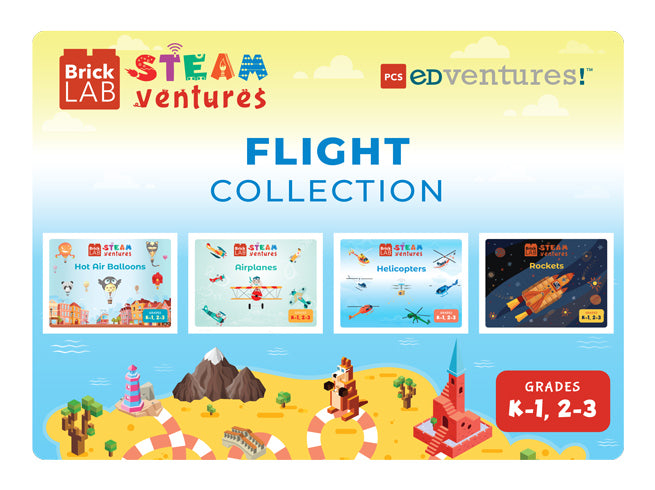
BrickLAB STEAMventures: Flight Collection
Pricing Options:
- K-1st / 10-Student Bundle (Bricks + Books): 595.00 USD
- K-1st / 10-Student Bundle (Books Only): 280.00 USD
- 2nd-3rd / 10-Student Bundle (Bricks + Books): 595.00 USD
- 2nd-3rd / 10-Student Bundle (Books Only): 280.00 USD
Recommended Settings:
- Summer Camps
- Before & After-School Programs
- Classrooms
- Homeschools
Tech Requirements:
- Optional online extensions require an internet-connected device.
Each Issue Includes:
- Key Terms
- Step-by-Step Brick Build
- Science & Social Studies Content
- Math & Literacy Activities
- Art Integration
- Brick Engineering Challenge
- Unplugged & Digital Choiceboards for Family Engagement
Product Orientation:
- Half-hour free webinar orientation for purchases of $500+
- One-hour free webinar orientation for purchases of $1000+
- Additional training available for purchase
Each 10-Student Bundle (Bricks + Books) includes:
- Instructor Guide: 1
- Printed Student Materials: 10 sets
- 40-page BUILD Books: 4 per student (1 each of Hot Air Balloons, Airplanes, Helicopters and Rockets.)
- Individual Brick Kits: 10
- BrickLAB Bricks: 300+ per kit
- Brick Separator: 1 per kit
- Mesh Bag (for cleaning bricks): 1 per kit
Each 10-Student Bundle (Books Only) includes:
- Instructor Guide: 1
- Printed Student Materials: 10 sets
- 40-page BUILD Books: 4 per student (1 each of Hot Air Balloons, Airplanes, Helicopters and Rockets.)
K-1st & 2nd-3rd Grade
Habits of Mind:
16 thinking habits developed by Art Costa and Bena Kallick to empower students to succeed in a 21st-century learning environment.
- Persisting
- Thinking Flexibly
- Striving for Accuracy
- Creating, Imagining, Innovating
21st Century Skills:
A set of widely-applicable abilities essential for success in the information age.
- Creativity and Innovation
- Flexibility and Adaptability
- Initiative and Self-Direction
- Productivity and Accountability
© 2019 Battelle for Kids. battelleforkids.org. All Rights Reserved. Battelle for Kids was not involved in the production of this product and does not endorse it.
Next Generation Science Standards:*
- NGSS K-2-ETS1-1 Engineering Design
- NGSS K-2-ETS1-2 Engineering Design
- NGSS K-2-ETS1-3 Engineering Design
- NGSS Core Idea PS1.B Chemical Reactions
- NGSS Crosscutting Concept 6. Structure and Function
- NGSS Practice 3 Planning and Carrying Out Investigations
- NGSS Practice 4 Analyzing and Interpreting Data
- NGSS Practice 6 Designing Solutions
* Next Generation Science Standards and NGSS is a registered trademark of WestEd. Neither WestEd nor the lead states and partners that developed the Next Generation Science Standards were involved in the production of this product, and do not endorse it.
K-1st Grade
Common Core State Standards for Mathematics:
- CCSS.MATH.CONTENT.K.CC.A Know number names and the count sequence.
- CCSS.MATH.CONTENT.1.MD.C.4 Organize, represent, and interpret data with up to three categories; ask and answer questions about the total number of data points, how many in each category, and how many more or less are in one category than in another.
- CCSS.MATH.CONTENT.1.NBT.A.1 Count to 120, starting at any number less than 120. In this range, read and write numerals and represent a number of objects with a written numeral.
- CCSS.MATH.CONTENT.1.NBT.C.4 Add within 100, including adding a two-digit number and a one-digit number, and adding a two-digit number and a multiple of 10, using concrete models or drawings and strategies based on place value, properties of operations, and/or the relationship between addition and subtraction; relate the strategy to a written method and explain the reasoning uses. Understand that in adding two-digit numbers, one adds tens and tens, ones and ones; and sometimes it is necessary to compose a ten.
- CCSS.MATH.CONTENT.1.OA.C.6 Add and subtract within 20, demonstrating fluency for addition and subtraction within 10. Use strategies such as counting on; making ten; decomposing a number leading to a ten; using the relationship between addition and subtraction; and creating equivalent but easier or known sums.
© Copyright 2010. National Governors Association Center for Best Practices and Council of Chief State School Officers. All rights reserved.
Common Core State Standards for English Language Arts:
- CCSS.ELA-LITERACY.L.1.1.B Use common, proper, and possessive nouns.
- CCSS.ELA-LITERACY.L.1.1.E Use verbs to convey a sense of past, present, and future (e.g., Yesterday I walked home; Today I walk home; Tomorrow I will walk home).
- CCSS.ELA-LITERACY.RI.1.1 Ask and answer questions about key details in a text.
- CCSS.ELA-LITERACY.RI.1.4 Ask and answer questions to help determine or clarify the meaning of words and phrases in a text.
- CCSS.ELA-LITERACY.RI.1.5 Know and use various text features (e.g., headings, tables of contents, glossaries, electronic menus, icons) to locate key facts or information in a text.
- CCSS.ELA-LITERACY.RI.1.10 With prompting and support, read informational texts appropriately complex for grade 1.
- CCSS.ELA-LITERACY.RL.1.10. With prompting and support, read prose and poetry of appropriate complexity for grade 1.
- CCSS.ELA-LITERACY.W.1.8. With guidance and support from adults, recall information from experiences or gather information from provided sources to answer a question.
© Copyright 2010. National Governors Association Center for Best Practices and Council of Chief State School Officers. All rights reserved.
Next Generation Science Standards:*
- NGSS K-PS2-2 Forces and Motion
- NGSS Core Idea ESS1.A The Universe and Its Stars
* Next Generation Science Standards and NGSS is a registered trademark of WestEd. Neither WestEd nor the lead states and partners that developed the Next Generation Science Standards were involved in the production of this product, and do not endorse it.
Idaho Content Standards for Social Studies:
- K.SS.4.1.3. Identify personal traits, such as courage, honesty, and responsibility.
2nd-3rd Grade
Common Core State Standards for Mathematics:
- CCSS.MATH.CONTENT.2.MD.D.10 Draw a picture graph and a bar graph (with single-unit scale) to represent a data set with up to four categories. Solve simple put-together, take-apart, and compare problems using information presented in a bar graph.
- CCSS.MATH.CONTENT.2.NBT.A.1 Understand that the three digits of a three-digit number represent amounts of hundreds, tens, and ones; e.g., 706 equals 7 hundreds, 0 tens, and 6 ones.
- CCSS.MATH.CONTENT.2.NBT.A.3 Read and write numbers to 1000 using base-ten numerals, number names, and expanded form.
- CCSS.MATH.CONTENT.2.NBT.B.5 Fluently add and subtract within 100 using strategies based on place value, properties of operations, and/or the relationship between addition and subtraction.
- CCSS.MATH.CONTENT.2.NBT.B.6 Add up to four two-digit numbers using strategies based on place value and properties of operations.
- CCSS.MATH.CONTENT.2.NBT.B.7 Add and subtract within 1000, using concrete models or drawings and strategies based on place value, properties of operations, and/or the relationship between addition and subtraction; relate the strategy to a written method. Understand that in adding or subtracting three-digit numbers, one adds or subtracts hundreds and hundreds, tens and tens, ones and ones; and sometimes it is necessary to compose or decompose tens or hundreds.
© Copyright 2010. National Governors Association Center for Best Practices and Council of Chief State School Officers. All rights reserved.
Common Core State Standards for English Language Arts:
- CCSS.ELA-LITERACY.RI.2.1 Ask and answer such questions as who, what, where, when, why, and how to demonstrate understanding of key details in a text.
- CCSS.ELA-LITERACY.RI.2.4 Determine the meaning of words and phrases in a text relevant to a grade 2 topic or subject area.
- CCSS.ELA-LITERACY.RI.2.5 Know and use various text features to locate key facts or information in a text efficiently.
- CCSS.ELA-LITERACY.RI.2.10 By the end of year, read and comprehend informational texts, including history/social studies, science, and technical texts, in the grades 2-3 text complexity band proficiently, with scaffolding as needed at the high end of the range.
- CCSS.ELA-LITERACY.RL.3.10. By the end of the year, read and comprehend literature, including stories, dramas, and poetry, at the high end of the grades 2-3 text complexity band independently and proficiently.
- CCSS.ELA-LITERACY.W.2.8. Recall information from experiences or gather information from provided sources to answer a question.
- CCSS.ELA-LITERACY.L.3.1.A Explain the function of nouns, pronouns, verbs, adjectives, and adverbs in general and their functions in particular sentences.
© Copyright 2010. National Governors Association Center for Best Practices and Council of Chief State School Officers. All rights reserved.
Next Generation Science Standards:*
- NGSS 3-PS2-2 Forces and Motion
- NGSS Core Idea PS1.A Structure and Properties of Matter
* Next Generation Science Standards and NGSS is a registered trademark of WestEd. Neither WestEd nor the lead states and partners that developed the Next Generation Science Standards were involved in the production of this product, and do not endorse it.
Idaho Content Standards for Social Studies:
- 2.SS.4.3.1. Identify characteristics of good citizenship, such as courage, honesty, and responsibility.
Jill Janicek
Jill has been teaching in the West Ada School District in Meridian, Idaho for 27 years and has taught grades K, 1, 2, and 5. She is a life-long learner and advocate for project-based learning. She has had training by PCS Edventures at the SySTEMic Summer Institute and written grants for BrickLABs. She and Dori Atterberry have led professional development for fellow educators at the i-STEM Summer Institute for 5
years using PCS Edventures BrickLAB kits. Jill also uses BrickLAB in her classroom, from individual designs with directions all the way to a project-based learning experience in groups of 4-5. They have even had times where the entire class builds together! Jill has been involved in several STEM summer camps for children as well, and she is very excited to share new ideas with you and your students, wherever they might be!
Dori Atterberry
Dori is a 1st grade teacher at Galileo STEAM Academy, a STEM certified school in Eagle Idaho, and brings over 30+ years of teaching experience. She holds a BA in Elementary Education with a minor in Early Childhood, is certified by the National Board and is a life-long learner and advocate for project-based learning. In her classroom, Dori uses bricks at her morning centers and integrates bricks with math,
literacy and science to create project-based learning units. She has taught at Camp Invention, a summer program in Idaho and has been a camp director for STEMbus summer camps as well. Dori has also had the pleasure of leading BrickLAB professional development sessions at the i-STEM Summer Institute, making her a BrickLAB expert and enthusiast!
My third-grade STEM class is a large group of high-energy, high-behavior kids I struggle to engage meanginfully for long periods. I completed the hot air balloon project with them and saw such a shift in behavior and engagement! Every group completed the challenge and surprised me with their focus and creativity. This was a game changer and I'm excited to use more brick lab with them and my other students!
My school will be starting all online this fall and I have been looking for some creative STEAM activities. The learning activities and choice boards will be a great fit for my art class.
Great resource that parents would feel comfortable helping their child with.
I really think that this activity would align with the curriculum that we have.
This looks like an engaging set of activities that will introduce students to problem solving and design.





